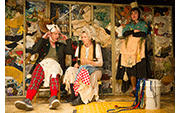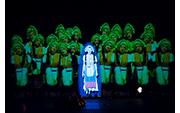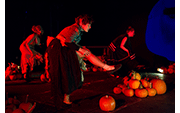
Philip Sandstrom
|
Ich, Kürbisgeist
Produced by Big Dance Theater “Ich, Kürbisgeist” by Paul Lazar Interview with director of Ich, Kürbisgeist, Paul Lazar by Philip Sandstrom Oct 30, 2013 Philip Sandstrom: The press release talks about quasi-medieval landscape, invented language, and 100 pumpkins. How did you come up with this idea for this particular project? Paul Lazar: Our attachment (to this piece) had to do with the playwright, Sibyl Kempson, who is current writing for ERS (Elevator Repair Service, a theater company) and the Rude Mechanicals (a theater company) from Boston. She's just a great playwright. A read this play of hers (Ich, Kürbisgeist), it was intriguing, it was written in it's own sort of language, it was baffling, it was hilarious. At first reading it felt very different but the more you hang out with this piece of writing that she created the more you realize that the stupidity that is at the soul of the world that she describes is often at the soul of our own world. Which is it has a base level of brutality that is second nature. PS: So, Sibyl, wrote this play independent of Big Dance Theater doing Ich, Kürbisgeist, it wasn't a commissioned work. PL: Yes, she wrote it prior to Ich, Kürbisgeist, we didn't commission the play. But it's the kind of play that probably no one would ever do. PS: Tell me again how you ran across this play? PL: Well, I love Sybil's writing… PS: So, you worked with her before? PL: I've always looked for the opportunity to work with her, because I've read all of her scripts hoping to find one that would with the esthetic of our company (Big Dance Theater). And this was the one that fit. I've always been aware of her work, I've read everything that she's written, and I even directed a version of a play of her's working with high school kids. I was just waiting for the one that would fit (with BDT) and this fit. PS: When and where did you first become aware of her work? PL: You know where? There's this series that's been going on in New York for at least ten years, called the "Catch" series, this series is run by Caleb Hammonds, Jeff Larson, and Andrew Dinwiddie. I saw a small piece of one of Sybil's plays, a seven minute piece, in a "Catch" presentation and I was aware of Sybil because Sybil is a graduate of the writing program founded at Brooklyn College by Mac Wellman. I love Mac's writing and I've done Mac's plays and Mac recommended Sybil to our company. PS: You chose this particular work. How true are you being to the work and how much influence has Sybil had on your interpretation? PL: We are being completely true to the work. We didn't change anything in it. But we, I, kept Sybil a little bit at bay, in terms of her contribution to the directorial aspects. Because, as we've openly said to one another, Sybil and I have a slightly different idea of what we want it to be like. PS: The invention of the language of came directly from the play, can you touch on, and explain, the amalgam of English, Swedish, German, and Sid Caesar. I can imagine the first few but could you enlighten me about Sid's contribution? PL: It's not literally Sid Caesar but the reason we invoke his name… one of his famous routines was he could do made-up languages. PS: Oh, yeah, his gibberish…but it would make sense. PL: Yes, and that's what it shares… there are two things that this language (in Ich, Kürbisgeist) shares with Sid Caesar; it's funny and it makes sense. They're (the audience) not going to get a lot of the words but you definitely get the comedic sense and meaning of what is being communicated because there is specificity and a rate to the language that makes it very graspable. PS: What sort of techniques are you using to help us understand this language, in terms of pacing and in terms of how you work it? PL: In rehearsal we spent much more time sitting still at our table, a lot of time with BDT we're on our feet immediately, here we sat still and wrestled with the language until it got as natural for us as our own English is to us. PS: Have you found yourself communicating with each other in this language? PL: Yes it completely takes over brain. PS: Tell me how the movement aspects of this show interweave with the play PL: It's probably got less dance in it, it does have some, it's got a couple, but this is a culture, the play describes a culture that is very static. They sit in one place until they have to move. They hate to get off their asses for anything. And if they get off it's to smash something or break something and then they sit back down and rest. PS: How do the pumpkins play into this scenario? PL: They smash the pumpkins; they crush them and smash them just for stupid pleasure. This whole play came out of Sybil's tour to Germany. She saw a field of smashed pumpkins, she asked her German friend, who was driving the car, what happened in that field. She was told it was the such and such festival (name unknown by PL) we just smash the pumpkins and leave them to rot out in the sun. She thought about the Charlie Brown "Great Pumpkin" and she thought it (the pumpkin smashing) was brutal; there was something very brutal about it. PS: So the smashing of pumpkins is an innate part of the script? There are stage directions like smash pumpkin here? PL: Yeah, yeah, it's written into the script. You know it's like our culture were will buy something made out of plastic then just throw it away. So, you've got the ocean filled with plastic, but we still just keep doing it. It has that kind of spirit to it. PS: What are the contributions that your company brings to this work? PL: The contributions are two-fold; in it's origins the script is just a bunch of weird language on paper, it doesn't have a world yet, we had to make the world, and we had to make the characters who inhabit the world. The audience is placed in the middle of the set on swivel chairs, like office chairs, on one side of the audience there is a very cramped tight space where the characters live, then you look in the other direction and see a vast pumpkin patch. The costumes, the characters, the crude medieval dances, everything that makes the world, other than the way we speak is all created by the company. PS: So, the audience is in the center and everything orbits around the audience? PL: Right! PS: There are some familiar company members like Tymberly Canale and Cynthia Hopkins; I notice that Molly Hickok (a long-time company member) is not in the show. This might be a sensitive question but why isn't Molly in the show? PL: She was originally in the cast, but for physical reasons, she's hasn't been performing as much recently, and she elected not to be in this version. It was good fortune that Cynthia, after ten years of making her own work, was starting to make herself available to work with other people. As you know, we have a long relationship with Cynthia and she was able to slip right into Molly's part. PS: How does that work working with someone who's become such an established creator of her own work? PL: We started working with Cynthia right when she got out of school; as far as the way we work with her we continued working in the spirit that we originally started out working with her. Nothing has changed except that we're probably a little better at what we do because we've done it longer and she was great from the beginning but she's even better now because she's such a gargantuan performer. PS: Getting back to the language of the play, does the playwright provide some sort of pronunciation guide? PL: Sybil comes to rehearsal to help us with pronunciation she also created a video which has all the enigmatic pronunciations. We worked with that very meticulously for a long time to get it. Now that we've reopened the show we've returned back to that original source. The thing that keeps it from becoming a Saturday Night Live routine is being very meticulous about what the language asks of you (the performer). If you get sloppy with the language you get sloppy with your whole performance. It's our grounding it's our foundation. PS: Is there an alphabet in addition to this pronunciation guide? PL: It's our alphabet (Latin alphabet) there are some letters like an O with a slice through it is pronounce as a long "O"; she's added some symbols such as these to letters in our alphabet (that have unique sounds). PS: Do you find that you can create conversation in this language that is not in the script with other people in the cast? PL: Yeah, that just starts to happen. It's funny we all start talking that way. Tymberly's husband was getting so annoyed with her because she was talking to him in another language. It's was pissing him off and driving him nuts. He was hating the show before he saw it, but when he saw it he really loved it. PS: Tell me a bit about your other collaborators, set, video, lighting, sound…. PL: Josh is our video guy, the importance of video is…. These characters destroy their own world and a vengeful God the mythic defenders of the pumpkins, it's all ridiculous, he comes down and destroys their world; just wipes us all out. To get that vengeful God into the room required an extraordinary video. Leroy, the guy from Antigone (past BDT show) the huge guy with a huge white beard made a video comeback in this show; he's the vengeful God. Karinne Keithley, also created some of the video. This world has multiple times zones and times, people mingle across times and history. To create this all we needed very subtle and at times very bold video and sound. Our sound guy is the great Ben Williams; he does a lot of the sound for ERS. When the vengeful God makes his entrance we've really got to rattle the roof; Ben can do that in a way that not just abrasive but thrilling. PS: Sorry to keep jumping around but getting back to the setting, how did you come up with the audience in the center idea; this doughnut stage? PL: Good question, it's sort of hard to trance it, it was more of an intuitive decision. But now that we made it, it makes it possible for the audience to look in one direction and see the whole town cramped into one little tiny hovel. And then they turn around and they see this vast endless expanse of pumpkins. So, it (this seating arrangement) made it possible to do interior and exterior at the same time. PS: Is it a panorama that we see? PL: And between the pumpkin patch and the hovel we see the living environment of the waxed old woman and her son the gentle clergy who are these Puritanical perverse characters who enter into the drama. On the fourth side you see all the tech world in these great costumes, you see the mechanism, the machinery. It's sort of like Oz behind the curtain; you see everything from your swivel chair seat.
Photos by Ian Douglas. |
| museums | NYTW mail | recordings | coupons | publications | classified |





